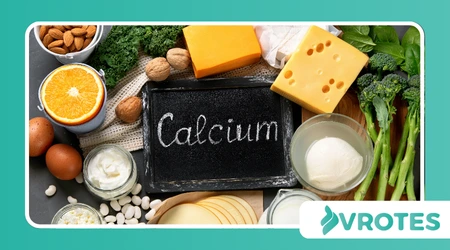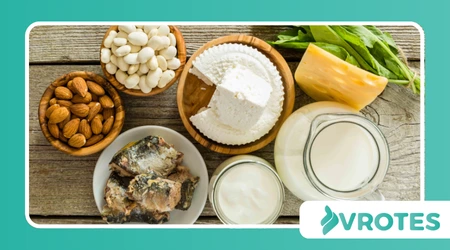Dairy vs. Plant-Based: Choosing Calcium Sources Post-50

Dairy vs. plant-based. As we age, our bodies undergo significant shifts. For women, the post-menopausal years bring a natural decline in estrogen.
This hormonal change directly impacts bone density, increasing the risk of osteoporosis.
Calcium, the building block of our skeletal system, becomes an even more critical nutrient.
It’s not just about strong bones; calcium also plays a role in nerve function, muscle contraction, and blood clotting.
Dairy: A Traditional Pillar of Calcium Intake
For decades, milk, yogurt, and cheese have been synonymous with calcium. Dairy products are indeed rich in this mineral and often fortified with Vitamin D, which is essential for calcium absorption.
Many individuals find dairy convenient and readily available, making it a staple in their diets.
The Plant-Based Revolution: A Growing Alternative
However, the landscape of nutrition is evolving. A significant number of people are now exploring or adopting plant-based diets.
This shift is driven by various factors, including ethical considerations, environmental concerns, and perceived health benefits.
For those choosing this path, finding adequate calcium sources requires a more mindful approach.
Unpacking the Nutrient Profile: Beyond Just Calcium
When we compare dairy vs. plant-based calcium sources, it’s crucial to look beyond just the calcium content.
++ Low-Glycemic Snacks to Stabilize Blood Sugar During Menopause
Dairy provides other nutrients like protein, B vitamins, and sometimes beneficial probiotics. Plant-based alternatives, on the other hand, offer a different spectrum of nutrients.
They often come packed with fiber, antioxidants, and a variety of vitamins and minerals unique to plants.
Bioavailability: How Much Calcium Does Your Body Actually Use?
It’s not merely about how much calcium is in a food, but how much your body can actually absorb and utilize. This is known as bioavailability.
Some plant compounds, like oxalates in spinach or phytates in legumes, can slightly inhibit calcium absorption.
However, this doesn’t mean these foods aren’t valuable sources. Preparing them correctly, like soaking or cooking, can reduce these effects.

Fortification: Bridging the Nutritional Gap
Many plant-based milks, yogurts, and even orange juices are now fortified with calcium and Vitamin D. This fortification plays a vital role in ensuring that individuals on plant-based diets can meet their calcium needs without significant difficulty.
Always check labels to confirm fortification levels.
The Gut Microbiome Connection: A New Perspective
Emerging research is highlighting the intricate connection between our gut microbiome and nutrient absorption, including calcium.
Some studies suggest that specific gut bacteria might influence how effectively our bodies absorb minerals.
Read more: The Best Phytoestrogen Foods for Hormonal Balance
This adds another layer to the dairy vs. plant-based discussion, as different dietary patterns can foster distinct microbial communities.
Navigating Lactose Intolerance and Allergies
For a considerable portion of the global population, dairy consumption comes with challenges.
Lactose intolerance, a common digestive issue, can cause discomfort and lead many to seek alternatives.
Dairy allergies, though less common, necessitate complete avoidance. In these cases, plant-based options become not just a choice, but a necessity for well-being.
Considering Environmental and Ethical Footprints
Beyond personal health, many individuals are weighing the environmental and ethical implications of their food choices.
The dairy industry has a significant carbon footprint and raises concerns about animal welfare for some.
Read here: Natural Supplements for Mood Swings: What Science Says
Plant-based alternatives often offer a more sustainable and compassionate option, aligning with a growing desire for eco-conscious living.
Practical Choices for a Calcium-Rich Diet
Regardless of whether you choose dairy or plant-based, a balanced and varied diet is key.
Think of your daily calcium intake as a mosaic, where different pieces contribute to the overall picture. Don’t rely on just one source.
Dairy Calcium Powerhouses
| Dairy Product | Typical Calcium per Serving (approx.) |
| Milk (1 cup) | 300 mg |
| Yogurt (1 cup) | 450 mg |
| Cheddar Cheese (1.5 oz) | 300 mg |
These are general guidelines; actual values may vary by brand and fat content.

Plant-Based Calcium Champions
For those opting for plant-based sources, the options are plentiful and diverse.
Fortified plant milks (almond, soy, oat), tofu (calcium-set), fortified orange juice, and dark leafy greens like kale and collard greens are excellent choices.
Broccoli, calcium-fortified cereals, and some nuts and seeds also contribute. Imagine your plate as a vibrant garden, each component offering its unique nutritional gift.
The Vitamin D Partnership: An Essential Duo
Calcium doesn’t work alone. Vitamin D is its indispensable partner, facilitating calcium absorption in the gut.
Sunlight exposure is a primary source of Vitamin D, but dietary sources and supplements are often necessary, especially in regions with limited sun.
Many dairy and plant-based milks are fortified with Vitamin D for this very reason.
Beyond Diet: Lifestyle Factors for Bone Health
While diet is paramount, other lifestyle factors significantly impact bone health. Regular weight-bearing exercise, like walking, jogging, or dancing, stimulates bone formation.
Avoiding smoking and excessive alcohol consumption are also crucial for maintaining bone density. It’s a holistic approach, not just a dietary one.
The Importance of Professional Guidance
Before making significant dietary changes, especially concerning bone health, consulting a healthcare professional or a registered dietitian is always advisable.
They can assess individual needs, consider any underlying health conditions, and provide personalized recommendations to ensure optimal calcium intake.
Every body is unique, and what works for one person might not be ideal for another.
Dispelling Misconceptions: The Truth About Plant Proteins
A common concern when discussing dairy vs. plant-based diets is protein intake. Rest assured, plant-based diets can provide ample protein.
Legumes, lentils, nuts, seeds, and whole grains are all excellent sources. The key is variety to ensure a complete amino acid profile.
An Illustrative Example: Maria’s Calcium Journey
Consider Maria, a vibrant 62-year-old. For years, she relied on dairy for her calcium. However, after developing lactose intolerance, she transitioned to a plant-based diet.
She now enjoys calcium-fortified almond milk in her morning smoothie, incorporates calcium-set tofu into stir-fries, and snacks on fortified orange juice and kale chips.
Her bone density scans remain strong, demonstrating the efficacy of a well-planned plant-based approach.
Another Perspective: A Different Path to Wellness
Then there’s Elena, 55, who thrives on dairy. She ensures her diet includes low-fat milk, Greek yogurt, and a variety of cheeses.
She also incorporates plenty of calcium-rich vegetables and gets regular sun exposure.
Elena’s approach showcases that a dairy-inclusive diet, when balanced, can also effectively support bone health.
Both Maria and Elena achieve their calcium goals through different, equally valid, paths.
The Power of Individual Choice
Ultimately, the decision between dairy vs. plant-based calcium sources post-50 is a personal one.
It hinges on individual preferences, dietary restrictions, ethical beliefs, and health goals.
There isn’t a single “best” answer, but rather a “best for you” answer. The most important thing is to ensure adequate calcium intake from whichever sources you choose.
What truly matters is consistent nourishment.
The Bigger Picture: Beyond Just One Nutrient
While calcium is a star player, remember it’s part of a larger orchestra of nutrients that contribute to overall health.
Focus on a whole-food-based diet rich in fruits, vegetables, lean proteins, and healthy fats.
This holistic approach supports not only bone health but also cardiovascular health, cognitive function, and general well-being.
Are we truly prioritizing the full spectrum of our nutritional needs?
The Future of Food: Innovation and Accessibility
The food industry continues to innovate, offering an ever-expanding array of nutritious options.
Plant-based alternatives are becoming more sophisticated and readily available, making it easier than ever to make informed dietary choices.
This ongoing evolution empowers individuals to tailor their diets to their unique needs and preferences.
A recent statistic shows that the global plant-based food market is projected to reach over $162 billion by 2030, highlighting this significant shift.
Analogy: Building a Sturdy House
Think of your bones like the framework of a house.
Just as a house needs strong, consistent materials to withstand time and weather, your bones need a steady supply of calcium and other essential nutrients to remain resilient.
Whether you choose bricks (dairy) or sustainably sourced timber (plant-based options), the goal is the same:
to build a sturdy, lasting structure. The choice of material is secondary to the quality of construction.
Conclusion: Empowering Your Nutritional Journey
For women over 50, the choice between dairy vs. plant-based calcium sources is an important consideration for bone health.
Both pathways offer valid and effective means to meet your calcium requirements.
The key lies in understanding the nutritional profiles, considering bioavailability, and ensuring adequate intake through a well-planned diet, supported by Vitamin D and an active lifestyle.
Embrace the journey of informed choices, and empower yourself with the knowledge to nourish your body optimally.
Frequently Asked Questions
Q: What is the main concern regarding calcium for women over 50?
A: The main concern is the loss of bone density due to decreased estrogen after menopause, which increases the risk of osteoporosis.
Q: Are dairy products the only effective source of calcium?
A: No, while dairy products are an excellent source, many fortified plant-based options and foods like dark leafy greens and fortified tofu also provide significant calcium.
Q: Is Vitamin D important for calcium absorption?
A: Yes, Vitamin D is crucial for calcium absorption in the intestine, making it an indispensable partner for bone health.
Q: Do I need to consult a doctor or nutritionist before changing my diet?
A: Yes, it’s always advisable to seek guidance from a healthcare professional or nutritionist to ensure your individual needs are met and that dietary changes are safe and effective.
Q: What else, besides diet, affects bone health?
A: Weight-bearing exercises, avoiding smoking, and limiting excessive alcohol consumption are crucial for maintaining bone density.
++ Calcium Absorption from Food Products: Food Matrix Effects
++ Are plant-based milks healthier or less nutritious than cow’s milk?
